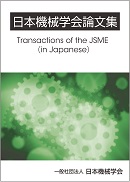Volume 86, Issue 885
Displaying 1-10 of 10 articles from this issue
- |<
- <
- 1
- >
- >|
Fluids Engineering
-
2020 Volume 86 Issue 885 Pages 19-00455
Published: 2020
Released on J-STAGE: May 25, 2020
Advance online publication: April 28, 2020Download PDF (2460K) -
2020 Volume 86 Issue 885 Pages 20-00041
Published: 2020
Released on J-STAGE: May 25, 2020
Advance online publication: April 15, 2020Download PDF (1791K) -
2020 Volume 86 Issue 885 Pages 20-00047
Published: 2020
Released on J-STAGE: May 25, 2020
Advance online publication: April 27, 2020Download PDF (1202K)
Dynamics & Control, Robotics & Mechatronics
-
2020 Volume 86 Issue 885 Pages 18-00460
Published: 2020
Released on J-STAGE: May 25, 2020
Advance online publication: April 20, 2020Download PDF (4115K) -
2020 Volume 86 Issue 885 Pages 19-00382
Published: 2020
Released on J-STAGE: May 25, 2020
Advance online publication: May 12, 2020Download PDF (2244K) -
2020 Volume 86 Issue 885 Pages 19-00402
Published: 2020
Released on J-STAGE: May 25, 2020
Advance online publication: April 16, 2020Download PDF (6233K) -
2020 Volume 86 Issue 885 Pages 19-00425
Published: 2020
Released on J-STAGE: May 25, 2020
Advance online publication: April 30, 2020Download PDF (2410K)
Computational Mechanics
-
2020 Volume 86 Issue 885 Pages 20-00061
Published: 2020
Released on J-STAGE: May 25, 2020
Advance online publication: May 11, 2020Download PDF (13813K)
Design, Machine Element & Tribology, Information & Intelligent Technology, Manufacturing, and Systems
-
2020 Volume 86 Issue 885 Pages 19-00445
Published: 2020
Released on J-STAGE: May 25, 2020
Advance online publication: April 30, 2020Download PDF (3040K)
Bio, Medical, Sports and Human Engineering
-
2020 Volume 86 Issue 885 Pages 20-00063
Published: 2020
Released on J-STAGE: May 25, 2020
Advance online publication: May 12, 2020Download PDF (1938K)
- |<
- <
- 1
- >
- >|
